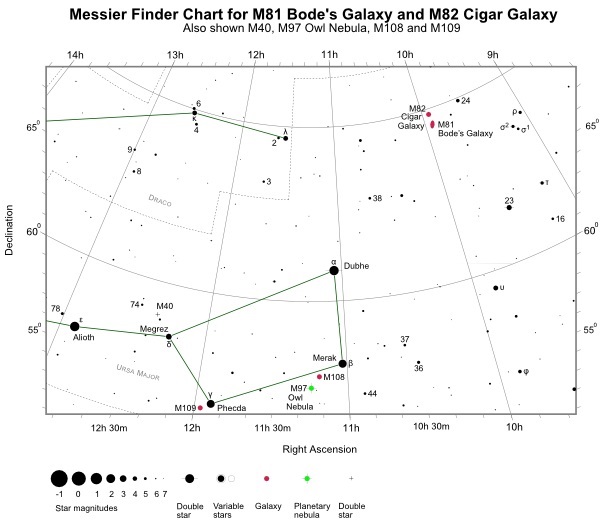M97, also known as the Owl Nebula, is a famous planetary nebula located in the constellation of Ursa Major. It was discovered by Pierre Mechain on February 16, 1781 and is one of only four planetary nebulae listed in the Messier catalogue. Although not particularly bright at magnitude +9.9, it's a superb object and regarded as one of the most complex examples of its type. The name Owl Nebula was first coined in 1848 by William Parsons the 3rd Earl of Rosse, who noticed owl-like "eyes".
Locating M97 is easy as it's positioned only 2.5 degrees southeast of bright star Merak (β UMa - mag. +2.3). This is the southwest corner star of the bowl of the famous Plough or Big Dipper asterism of Ursa Major. In the same wide field telescope field of view, 50 arc minutes northwest of M97, is barred spiral galaxy M108 (mag. +10.2).
The Owl Nebula is best seen from Northern Hemisphere latitudes during the months of March, April and May. From latitudes north of 35N, it's circumpolar and therefore never sets.


Finder Chart for M97 - pdf format (credit:- freestarcharts)

Due to its low surface brightness, the Owl Nebula is a challenging object for large binoculars and small telescope observers. It's visible in 20x80 binoculars and 100mm (4-inch) scopes, but usually requires very dark skies and excellent seeing conditions. It appears as nothing more than a dim circular disk or fuzzy ball without detail.
The famous eyes consist of two dark patches superimposed on the face of the nebula. Under good conditions, 200mm (8-inch) scopes at high powers can show the eyes but normally a 250mm (10-inch) scope is required. An ultra high contrast deep sky or light pollution filter may also help. M97's central star is of only 14th magnitude, making it an elusive target in anything less than a 350mm (14-inch) telescope.
M97 has an apparent size of 3.4 x 3.3 arc minutes. At a distance of 2,600 light-years this equates to an actual diameter of 3 light-years. It's a fantastic deep sky object that's estimated to be 8,000 years old. Although not bright, it's a worthy object on any observing list.
M97 Data Table
| Messier | 97 |
|---|---|
| NGC | 3587 |
| Name | Owl Nebula |
| Object Type | Planetary nebula |
| Constellation | Ursa Major |
| Distance (light-years) | 2,600 |
| Apparent Mag. | +9.9 |
| RA (J2000) | 11h 14m 48s |
| DEC (J2000) | 55d 01m 07s |
| Apparent Size (arc mins) | 3.4 x 3.3 |
| Radius (light-years) | 1.5 |
| Notable Feature | Owl like eyes visible through larger amateur telescopes. |